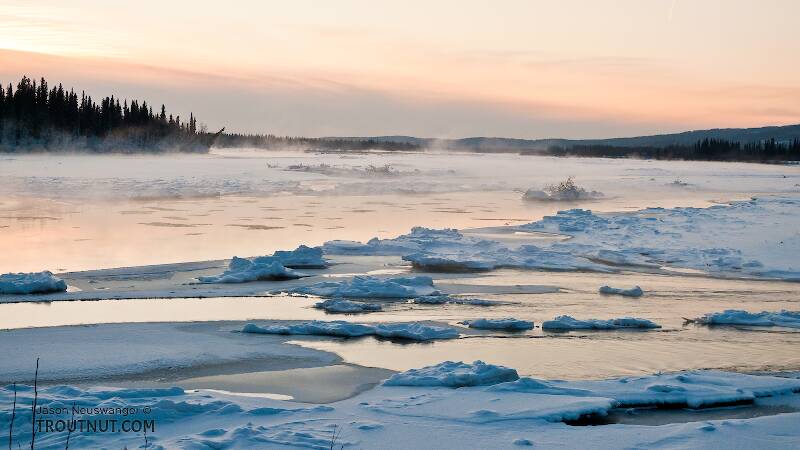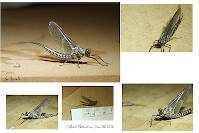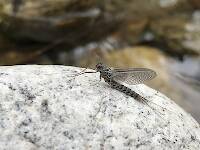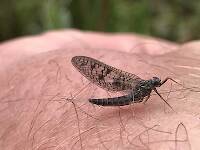
Salmonflies
Pteronarcys californica
The giant Salmonflies of the Western mountains are legendary for their proclivity to elicit consistent dry-fly action and ferocious strikes.
Featured on the forum

This one was surprisingly straightforward to identify. The lack of a sclerite at the base of the lateral hump narrows the field quite a bit, and the other options followed fairly obvious characteristics to Clostoeca, which only has one species, Clostoeca disjuncta.

Troutnut is a project started in 2003 by salmonid ecologist Jason "Troutnut" Neuswanger to help anglers and
fly tyers unabashedly embrace the entomological side of the sport. Learn more about Troutnut or
support the project for an enhanced experience here.
Wiflyfisher on Mar 9, 2014March 9th, 2014, 7:41 pm EDT
My new improved Brown Drake emerger pattern for 2014. I am not sure this will be any better until it's trout tested. I have often observed a lot of Brown Drake duns flopping around in the surface film while trying to get their wings upright and dry. So every year I try to create a more effective soft hackle pattern for the Brown Drake hatch that will be more deadly than the previous design. I also try to keep patterns simple and not too complicated.

I am using grouse hackle, Pearsall's olive silk thread for a ribbing, and the body is a mixture of golden wool color and natural hare's ear on a size #6 Mustad #3906 hook.
What do others use for this?

I am using grouse hackle, Pearsall's olive silk thread for a ribbing, and the body is a mixture of golden wool color and natural hare's ear on a size #6 Mustad #3906 hook.
What do others use for this?
John S.
https://WiFlyFisher.com
https://WiFlyFisher.com
Crepuscular on Mar 10, 2014March 10th, 2014, 5:59 am EDT
Matt, that Green Drake looks great! (Actually they all do...)
John, those soft hackles look pretty tasty too. I bet they would work for march browns too.
John, those soft hackles look pretty tasty too. I bet they would work for march browns too.
Oldredbarn on Mar 10, 2014March 10th, 2014, 1:09 pm EDT
It's funny how two guys see a fly so differently! my Brown Drake Emerger. I guess my nomemclature is incorrect.
Matt...I don't think so. They are just two different "styles", yours is dry and John's is wet. Your fly reminds me a bit of Harrop's transitional dun.
IMHO, these will take fish, no problem...
Your last one there Matt I would toss for the Brown Drake, but maybe only change the wing color. There is a fair amount of yellow in our Brown Drakes (the Robert's Yellow Drake from Grayling is spot on) and a rather difficult carmel/honey brown that's not so easy to duplicate...In the neighborhood of your abdomen.
John...I have posted here before a time I floated the North Branch of the Au Sable during the Brown Drakes and we found piles of stillborns in the slack water under a small dock. My guide friend would remind me, when my drag-free-floats became too drag-free, that the process of emergence for these larger bugs isn't a dainty thing...They disturb the water. A wet fly is killer during these times.
Eric...There is a wet fly in Nemes' "100 Years of the Wet Fly", or whatever it's called, that is great during the March Brown hatch. It is the one in there with a couple wraps of brown rooster hackle just behind the Partridge...It helps flair it out some. It also has a tail of PT fibers.
I had a wonderful day with this fly a couple years back. I fish it more like a dry than a wet...The next morning I ran in to Gates' Lodge and whispered this to Josh there...He smiled and walked me over to the fly bins and reach down and pulled something out of the Brown Drake bin that looked a great deal like what I had tied.
I guess that there really isn't anything "new" under the sun. :)
Thanks for sharing guys!
Spence
"Even when my best efforts fail it's a satisfying challenge, and that, after all, is the essence of fly fishing." -Chauncy Lively
"Envy not the man who lives beside the river, but the man the river flows through." Joseph T Heywood
"Envy not the man who lives beside the river, but the man the river flows through." Joseph T Heywood
Wiflyfisher on Mar 11, 2014March 11th, 2014, 4:24 am EDT
Matt, mine is not a dry fly like yours. For a dry fly pattern I prefer a Brown Drake Comparadun with the wing slightly slanted back.
There are so many variations for most patterns today it is difficult to remember what the heck the original patterns even looked like.
I guess that there really isn't anything "new" under the sun. :)
There are so many variations for most patterns today it is difficult to remember what the heck the original patterns even looked like.
John S.
https://WiFlyFisher.com
https://WiFlyFisher.com
Wbranch on Mar 11, 2014March 11th, 2014, 5:13 am EDT
My two dry emergers are tied on #8 & #10 hooks. I like to fish the upper East Branch in early June because of the intense BD & GD emergences - they overlap. I see many duns half in and half out of the nymphal shuck with the wings unfolding that I figured I'd try a dry emerger.
Catskill fly fisher for fifty-five years.
Quick Reply
Related Discussions
Topic
Replies
Last Reply
6
Jun 10, 2009
by Martinlf
by Martinlf
4
Sep 29, 2016
by Wiflyfisher
by Wiflyfisher
4
Jun 17, 2020
by Leskorcala
by Leskorcala











